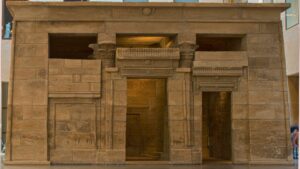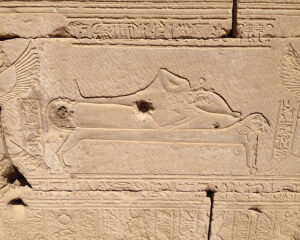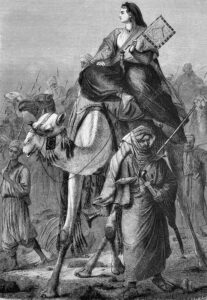Events
-
Online lezingen in mei
Dinsdag 4 mei
Dr. Mary Ann Marazzi
Ished tree scenes in ancient EgyptEvidence for ished tree scenes date from the reigns of Thutmosis I through that of the Roman ruler Hadrian. They appeared in both texts and images on temple walls and other monuments including obelisks, stelae, and statuary, but until recently they were not understood that well and were not collected and analysed as a unit. This presentation gives an overview of what an ished tree scene is and the function it had in ancient Egypt including a possible sequence of events for the ritual of the ished tree as well as who could see the images and read the texts.
4-6 mei
The Egyptological Conference in Copenhagen 2021
The theme of this year’s conference is trade and administration in Ancient Egypt, however, the presentations will cover a variety of topics within the field of Egyptology and archaeology.
Zaterdag 8 mei
Rosalind Janssen, Janet Johnstone & Elizabeth Clancy
Early Fashion and Textiles by the Nile, Euphrates and Tigris: ConversationsThis panel brings together scholars and practitioners who will introduce their studies of and encounters with ancient textiles, clothes, and fashion. Exploring practical textile and dress making techniques of the cultures along the Nile, Euphrates and Tigris rivers during the 3rd millennium BCE, they ask: How was fashion used to express cultural, societal, and personal identities? Find out how ancient fashion and clothes making techniques can influence the way we make, design, and wear textiles today.
Zaterdag 8 mei
Kelsey Museum
Animals in the Ancient WorldAnimals abound in the art and artifacts of the ancient Near East, Greece, Egypt, and Rome. On this guided tour, learn more about different aspects of animals in antiquity. We’ll take a look at animal-themed artifacts in the Kelsey and ask: Was that animal food? A laborer? A pet? A sacrificial victim? We’ll also discuss what kinds of animals were symbols of power and strength, and the meanings different animals had in the ancient world.
 Zondag 9 mei
Zondag 9 meiDr. Daniel Soliman
Topstukkenlezing over de tempel van TaffehDe tempel van Taffeh, die in de grote entreehal van het Rijksmuseum van Oudheden staat, werd in de 1ste eeuw na Chr. gebouwd in Taphis, een stad in het diepe zuiden van Egypte. Twee millennia later schonk de Egyptische overheid de tempel aan het Nederlandse volk. Deze lezing gaat over de lange geschiedenis van de tempel en de verschillende manieren waarop het gebouw door de eeuwen heen een bijzondere plek is geweest. Daniel Solimans verhaal neemt u mee op een reis door de tijd: van de Romeinse periode, via de laatantieke periode, de middeleeuwen, en de tweede helft van de vorige eeuw, naar de dag van vandaag.
Zondag 9 mei
Dr. Mariam Ayad
The God’s Wives of AmunKosten: £4
Since its inception at the beginning of the 18th dynasty, the office of the God’s Wife of Amun was closely associated with the priesthood. By the time the office reached its zenith in the 23-26th dynasty, that association became immortalized in the iconography of the God’s Wife’s small Osirian chapels at Karnak. This illustrated lecture focuses on the priestly duties of the God’s Wife and what might those scenes tell us about her status and role more broadly.
 Dinsdag 11 mei
Dinsdag 11 meiManon Schutz
Sleeping on the goddess’ back. The meaning of beds in ancient EgyptKosten: gratis voor donateurs en studenten, €5 voor niet-donateurs
Voertaal: EngelsIn deze lezing vertelt Manon Schutz ons in detail over de functie van bedden in het oude Egypte. Na een algemene inleiding en een definitie van het concept ‘bed’, worden het gebruik en de religieuze betekenis van dit meubelstuk besproken voor verschillende stadia van zijn lange geschiedenis. De nadruk zal vooral liggen op de funeraire sfeer, aangezien de meeste overgeleverde bedden afkomstig zijn uit graven. Daarnaast zal ook het gebruik van bedden in de dagelijkse praktijk worden besproken.
Woensdag 12 mei
Two lectures by MA students at Swansea University
Wig Snatched: Unveiling the process behind wig-making and the wig industry in ancient Egypt / From rats to robber flies: active pest control in ancient EgyptZaterdag 15 mei
Dr. Chris Naunton
The Amarna Blessed DeadKosten: £5
What happened after Akhenaten’s death? Where was he buried? Who succeeded him? We know that Tutankhamun’s reign saw the end of Akhenaten’s revolution and the restoration of the old ways, and the boy-king himself was the last of the family line. But it seems clear that there was at least one other pharaoh in between Akhenaten and Tutankhamun. Who were they? Could it have been Nefertiti? And who was Smenkhkare? Tantalising clues have been in tombs at Amarna and in the Valley of Kings. But how to make sense of them?
Woensdag 19 mei
Daniela Rosenow & Matthieu Götz
Dahschur – Recent Research in the Old Kingdom SettlementDahshur is one of the most important royal pyramid cemeteries of Ancient Egypt. The first part of this lecture will highlight one of the most recent discoveries, a new settlement most likely inhabited by the people who planned the pyramids. The second part will explore the application of latest technologies, benefiting archaeology, conservation and site managenment.
Woensdag 19 mei
Dr. Kucera (Qasr Dakhleh Project)
Archaeological investigations at al-Qasr and the Roman fort of Dakhleh OasisFor several years after the discovery of Greek documents at Kellis (Ismant al-Kharab), which revealed the existence of a Roman military camp (castrum) in the 4th century CE in Dakhleh Oasis, the location of a fort remained elusive for researchers. Between 2006 and 2007, a possible location for the fort was realised when the remains of substantially large walls and unusual structural features were observed at the Islamic settlement al-Qasr. This talk presents the results of surveys and excavations that lead to the identification of the fort, further discoveries related to the occupation of the site, and a review of the findings in light of the Roman military presence in the Western Desert.
Woensdag 19 mei
John C. Darnell (Yale University)
Setting a seal upon the desert: Protodynastic and Early Dynastyc augmentation and interpretation of Predynastic rock art in the Upper Egyptian desertRegistreren via gaelle.chantrain@yale.edu
Donderdag 20 mei
Cédric Gobeil (Museo Egizio, Turin)
In the footsteps of Ernesto Schiaparelli. The Museo Egizio’s current research at Deir El-MedinaWithin the framework of the French Archaeological mission at Deir El-Medina carried by the IFAO, the Museo Egizio of Turin is conducting research on a few Ramesside tombs located in the Western necropolis. These tombs have been chosen based on the many artifacts that belonged to the owners of these tombs and are now kept in the museum. In addition to giving the opportunity to perform a study on these fragile structures using new technologies, this fieldwork is a unique chance to recontextualize many objects of the museum’s collection by shedding a new and fresh light on them. This talk will be the opportunity to get a first glimpse at this work in progress.
Donderdag 20 mei
Prof. Dr. Jochem Kahl
Wo Myrrhe nicht mehr regnen und Weihrauch nicht mehr tropfen kann – Die verschollenen Tempel von AssiutDonderdag 20 mei
The Egypt Centre Curator’s Chats
Ancient Egyptian TextilesUsing items within the museum’s own collection as well as examples from elsewhere, we will discuss the importance of textiles in Ancient Egypt. We shall briefly explore textiles used for the preparation of death including a rare painted shroud dating back over 3000 years, and consider theories as to how the ancients were able to pleat their garments. We will also look at the “Coptic” textiles in the museum including some which are said to have been designed with the intent of tricking the evil eye.
Vrijdag 21 mei
7th Annual Birmingham Egyptology Symposium
Biography in ancient Egypt
Zaterdag 29 mei
Dr. Mennat-Allah El Dorry
Egyptian History and its Many Cuisines: An Exploration of Egyptian Food HistoryWhat is Egyptian cuisine? It is an amalgamation of thousands of years of culinary innovations, technological developments, and new crops and flavors. Egyptian cuisine(s) change(s) from one region to the next, and from one time period to another. This talk will explore the cuisines of each phase of Egyptian history, identifying some of the highlights or developments of each time period, starting with ancient Egypt and through to the 20th century. It will also investigate the transformations, and how these may or may not have had an impact on the face of today’s Egyptian food. The paper will also survey the different sources that scholars have available in order to study the history of Egyptian cuisine.
Zondag 30 mei
Dr. Joanne Backhouse
Women of Deir el-MedinaKosten: £5
Deir el-Medina housed the craftsmen who created the royal tombs during the New Kingdom. We often consider the lives of the workmen but less so the female residents. Examining predominantly figured and hieratic ostraca, female figurines, stela, and tomb scenes this talk attempts to shed light onto the daily lives of the female inhabitants. Their religious practices and afterlife expectations will also be considered.
-
Lezingen in april
 Dinsdag 13 april
Dinsdag 13 aprilNicky van de Beek (PhD student JGU Mainz)
De wonderbaarlijke reizen van Alexine TinneKosten: gratis voor donateurs van Huis van Horus, €5 voor niet-donateurs
Alexandrine Pieternella Françoise Tinne (1835-1869) was de dochter en erfgenaam van een vermogende handelaar, woonachtig in het deftige Den Haag. Naast haar passie voor fotografie hield ze er een voor die tijd ongebruikelijke reislust op na. Na de obligatoire winters in Italië en een hachelijke reis naar Scandinavië doet een griep in de Alpen haar uitwijken naar warmere oorden. Ze scheept in op een boot met bestemming Alexandrië, Egypte – een reis die de loop van haar leven zou bepalen.
Zaterdag 17 april
Professor Rosalie David
Egyptian Mummies And Modern ScienceKosten: £6
This unique facility uses medical and scientific tools to examine Egyptian mummies and humans for the physical evidence of disease, diet, medical and pharmaceutical treatments and religious practices to gain a better understanding of what life was like in Ancient Egypt. This talk will also describe current fieldwork being undertaken by the KNH Centre Missions in Egypt.
Zaterdag 17 april
Dr Joanne Backhouse (University of Liverpool)
Body Art: fashion statement or status indicatorKosten: £5
Through this lecture Joanne will examine the manifestations of body art, both on physical remains and decorative works of art from the Predynastic to the Coptic period. The relationship between the two datasets (physical remains and decorative arts) will be analysed. The significance of the imagery will be considered to evaluate the meaning of the adornment. Until the discovery of markings on ‘Ginger’, all physical evidence from ancient Egypt was found on the female form. The only males depicted with body art in Pharonic Egypt are foreigners – Libyans.
Dinsdag 20 april
Veerle van Kersen (KU Leuven)
Linnen onder de loep: een nieuwe interpretatie van textielproductie in het oude EgypteKosten: €4
Textiel was millennia lang één van de belangrijkste industrieën in Egypte, en vervulde zowel tijdens het leven als in de dood een essentiële functie. Door het arbeidsintensieve productieproces was het bovendien een kostbaar goed. Deze presentatie bespreekt de verschillende stappen in de Egyptische textielproductie aan de hand van wandschilderingen en grafmodellen. We vergelijken hoe deze scènes vroeger bekeken werden, en hoe we ze kunnen herinterpreteren in het licht van de nieuwe bevindingen. Vervolgens bekijken we de textielfragmenten in Brussel en Leiden en wat ze ons kunnen vertellen over de Egyptische linnenproductie.
Maandag 26 april
Maria Nilsson & John Ward
Recent Discoveries at Gebel el-SilsilaKosten: £5
Located some 60 km south of the grand Edfu Temple, and 65 km north of the stunning golden landscape of modern day Aswan, Gebel el-Silsila – “Kheny/Khenu” to the ancients – played an important role within the overall development of Dynastic Egypt. While the site was a vital strategic trading location, marking the boundary between Egypt and her southern neighbour Nubia, one of Egypt’s “nine bows” (chief enemies), it was first and foremost the source of a bountiful supply of prime Nubian sandstone for the building of pharaonic monuments throughout Egypt, particularly during the New Kingdom. In this lecture, Maria and John will reveal their latest New Kingdom discoveries, exploring the Temple of Sobek, the necropolis, Tutankhamun’s workers village and new finds from the quarries of Amenhotep and Ahkenaten.
Maandag 26 april
Meredith Brand
Life at a Middle Kingdom Amethyst Mine: Archaeology of Site 5, Wadi el-HudiAncient Egyptian jewelry is renowned for its beauty, and the purple amethyst jewels from Middle Kingdom royal and elite burials are particularly stunning. As a luxury item, the pharaoh and his administration seemed to have exerted a state monopoly on semi-precious stones like amethyst, yet many questions remain as to how this monopoly was managed and the lives of the miners engaged in back-breaking labor.
In 2014 the Wadi el-Hudi Expedition, directed by Kate Liszka (California State University San Bernardino) and co-directed by Bryan Kraemer (Robert and Frances Fullerton Museum of Art) and Meredith Brand (The American University of Cairo), began to address these questions through surveying and excavating the Middle Kingdom amethyst mining settlements at Wadi el-Hudi in the Eastern Desert.
Maandag 26 april
Dr. Manuela Lehmann (The British Museum London)
Amara West – Lebenswelten im Nubien der RamessidenzeitDie seit 2009 stattfinden Ausgrabungen und Auswertungen des Amara West Projektes des Britischen Museums beschäftigen sich mit einer Siedlung und zwei zugehörigen Friedhöfen aus der Ramessidenzeit in Nubien. Die Siedlung bestand bis in die Dritte Zwischenzeit hinein und wurde dann aufgrund klimatischer Veränderungen aufgegeben.
Forschungsschwerpunkte sind unter anderem das tägliche Leben der Einwohner dieser Siedlung, die in einer Kolonie fern ab der ägyptischen Hauptstadt wohnen.
Dinsdag 27 april
Mennat-Allah El Dorry (Ministry of Antiquities)
Archaeobotanical Research in Egypt: Much Wine and a Little FavaSince the late 19th c., the study of Egypt’s ancient flora has steadily contributed towards a clearer understanding of ancient lives and societies. Plants, after all, have been used as food, fodder, fuel, furnishings, medication, building materials, and variety of funerary and living rituals throughout Egyptian history. The production and disposal of plant products has left us a range of evidence that can be employed to make inferences about ancient lives. This talk will focus on the study of historic plant remains – archaeobotany – with reference to Egypt: its history and development, methodologies, and will present some particular case studies.
Donderdag 29 april, 18.00 uur
Peter der Manuelian (Boston)
George Reisner and the Giza Project at Harvard; studying the past with the tools of the futureDonderdag 29 april, 18.15 uur
Prof. Dr. Stephan J. Seidlmayer
“Tausend Jahre sehen auf euch herab!” Das Alte Ägypten und seine Vergangenheit. Befunde aus dem Pyramidenfriedhof von Dahschur


